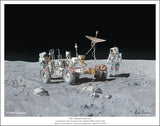During the Apollo missions it was considered that a vehicle would help the astronauts to greater explore their landing sites as well as collect and carry more samples. The Lunar Roving Vehicle was flown and used on the last three Apollo missions. It was an absolute marvel of engineering. It had to be compact and light weight enough to be able to fit into the Lunar Module. It also had to be able to endure lift-off and flight aboard the Saturn V. It had to be strong in order to transport two astronauts and rock samples. It also had to endure the harsh lunar environment including extreme temperatures and excessive dirt and dust. It had to be maneuverable and easily controllable over rugged terrain and remain absolutely reliable.
The Lunar Rover, developed by General Motors and Boeing, met all of these conditions and more. The vehicle as designed and deployed was battery powered. It weighed 460 lbs without astronauts or samples. It was designed to reach 8 MPH but could actually go over 11 MPH. Four rovers were built at a total cost of $38,000,000. They were driven an average of over 18 miles on each of the three missions on which they were used and there were no major mishaps. As of 2020 it remains the only manned vehicle operated on another world. One could say it is the ultimate exotic car.
This artwork depicts the Lunar Rover of Apollo 16. Commander John Young and LM Pilot Charlie Duke arrive at the edge of Ray Crater during their exploration of the Descartes Highlands.








